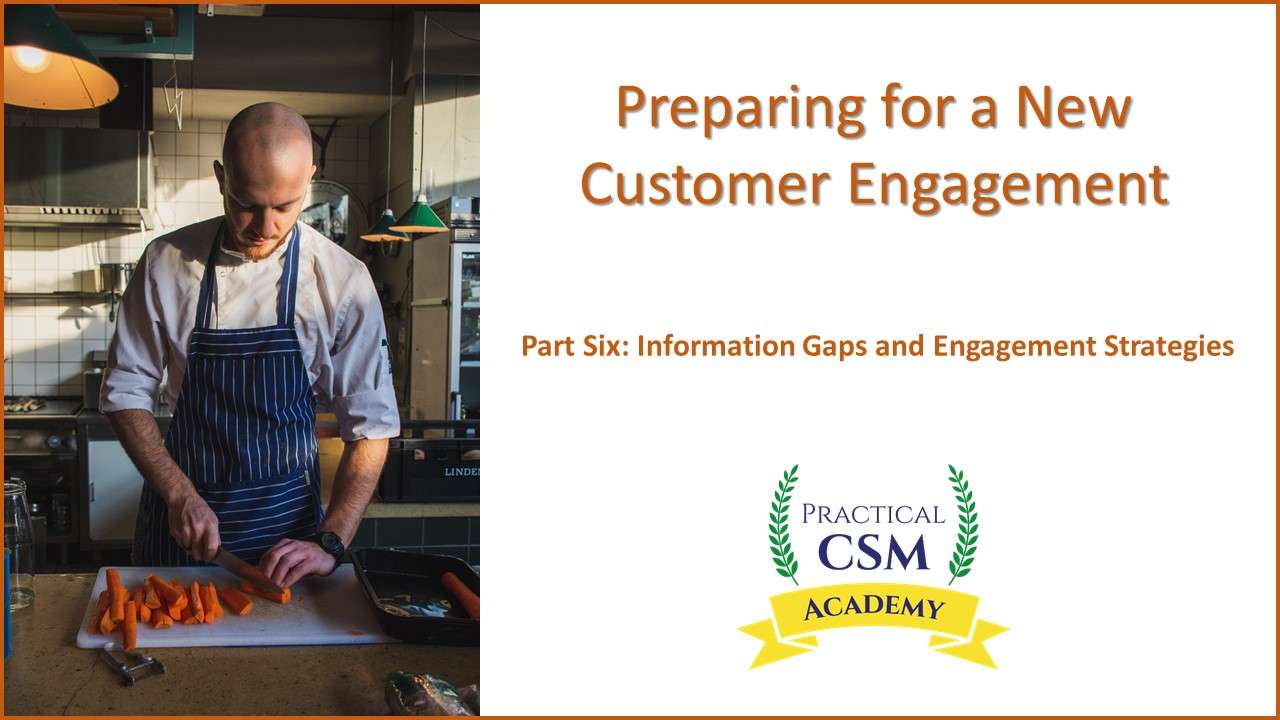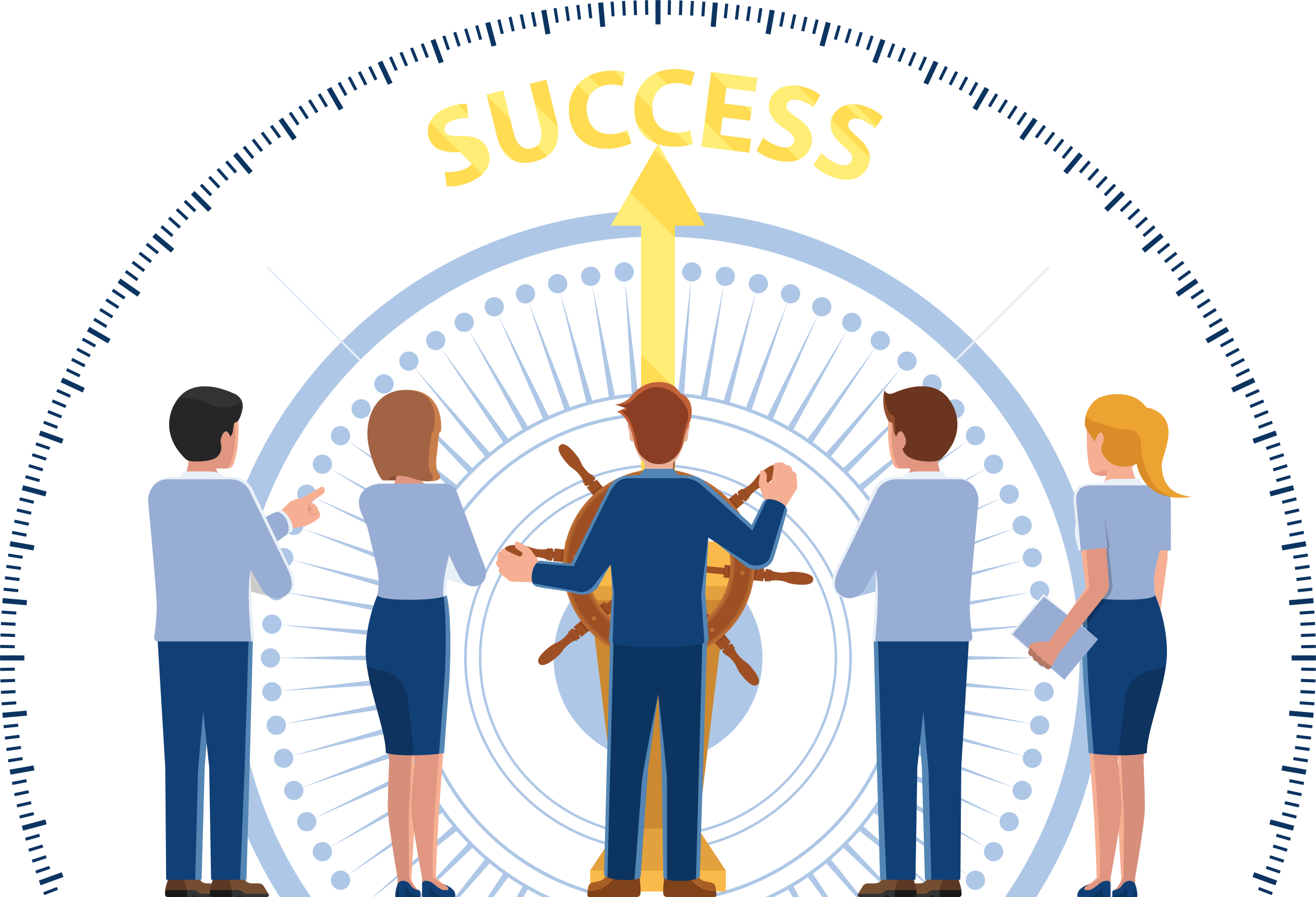Preparing for a New Customer Engagement
Part Six: Information Gaps and Engagement Strategies
Managing Information Gaps
What do we mean by “Information Gap”?
Once you have gone through the process of information gathering it is highly likely that you will have discovered “information gaps”. An information gap is simply a piece of information that you need but do not (yet) have. This can happen for all sorts of reasons. For example maybe the person who knows the information you need has not yet become available for you to talk to them. Or maybe it turned out that the person who should have known this information in fact did not know it, and now has to go and find out. Or maybe this information hasn’t even been created yet, and you have to wait until a report has been filed or data has been published. These are just some common examples, but there are many more reasons why it may not be possible for the CSM to complete their research in one go.
Planned and Unplanned Information Gaps
Of course on top of this there is also the question of the level of need for the as yet missing information. What is needed is a critical path, and the preferred approach is to only perform a sufficient amount of research, analysis and planning to enable the upcoming activity to take place, since too much time spent in research and analysis in the early stages can lead to a slowdown in both perceived (by the customer) and actual progress. So as well as information gaps that do need filling right now, there may also be information gaps that you do not intend to fill until later on. It is important that you can easily identify the difference between these different gaps. One suggestion for dealing with this is to color code the gaps according to whether they are planned (for example in green) or unplanned (for example in red).
Identifying Information Gaps
Identifying one or more information gaps is a very straightforward process if you use the tool I have provided for you, since it collates all research information together in one checklist. To identify information gaps, all you will need to do is review the checklist to spot the gaps, and perhaps color code those gaps as suggested above. If you are using a different system, or if your information is stored in a variety of places then you might need to do a little more work to calculate and document all the gaps, but in any case it is an important task which the CSM needs to make sure they have accomplished thoroughly.
Taking a Realistic Approach to Information Gaps
At the end of the day, the CSM will almost certainly experience what might be described as the law of diminishing returns when it comes to information gaps. Some as yet unknown but necessary information will be relatively straightforward to find, whereas other information may either less critical to know, or less easy to identify or both. In these circumstances the CSM may decide not to bother attempting to plus those particular gaps – at least not at this stage. As with most things it will come down to your own judgement as to what information is essential and worthwhile to invest further time and effort in uncovering and what information can be left unknown either for the time being or even entirely
Filling Information Gaps
Once you have determined what information is as yet unknown but needed to be uncovered, you need to go ahead and “plug the gaps” by discovering/uncovering the as yet unknown information. To do this may require some effort – even allowing for a certain amount of paring down of the list to include just the information that is essential to research at this stage in the customer engagement.
Dealing with “Unknown Unknowns”
Those of us with longer memories and an interest in politics may recall US Secretary of Defence Donald Rumsfeld discussing information gaps during one of his press briefings. In his parlance what we have discussed so far is the process of turning “known unknowns” (i.e. information that we know we need to know but which we do not yet already know) into “known knowns” (i.e. information that we know we need to know and which we do indeed know). However, there is a third category of information which is that of “unknown unknowns” (i.e. information that we do need to know but which we did not know we needed to know).
As you work through the customer engagement you will naturally progress in our understanding of the customer’s business, the initiative they are engaged in and your own solution and how it can help the customer to fulfil its stated objectives. In doing so you may well uncover an “unknown unknown” – a piece of new information that you hadn’t realized you would need to research but which you now find is necessary to uncover and learn about. This is natural and to be expected. By employing best practice techniques such as the use of the tools provided along with this book you can reduce the number of these unexpected additions, but inevitably they will still occur from time to time. Do not be alarmed by this; instead simply add them to the checklist and research them the same as any other information.
As your own CSM practice and that of your colleagues within the customer success team matures, so will your understanding of both your customers and your solutions. You will find that after multiple similar engagements you will have refined and improved what started off as generic tools and templates such as the ones accompanying this book into a highly polished set of tools that deal efficiently and effectively with the types of engagements you encounter in your role. Over time you will therefore be likely to encounter fewer such “unknown unknowns” than at first, though it is unlikely that the issue will ever go away entirely.
Formulating an Engagement Strategy
What is an engagement strategy and why do I need one?
This whole section is a slight aside from the topic of onboarding, as it discusses the concept and uses of an engagement strategy and how to formulate and engagement strategy roadmap. An engagement strategy is simply a high level plan of action that you have created for yourself to help you manage your activity within a particular customer engagement and to keep you on track with getting the results from that engagement that you and your company (and the customer) desire. This engagement strategy is part of the CSM’s leadership role in that it will help to set direction not just for the CSM but for others who the CSM will work with and whom the CSM may need to bring on board in order to gain their assistance in working towards a common goal.
For very simple and low priority customer engagements that do not have a lot of different tasks to consider and do not take place over any extended time period, an engagement strategy might be kept to a very simple to-do list, or not created at all. But for customer engagements with any level of importance and/or complexity and/or any duration over a week or so, it’s good practice to get an engagement strategy written down. It means that not only can you follow the strategy yourself, but if necessary (for example if you become ill, or take leave, or if you are seconded onto an important project and need to divest yourself of some of your other work) your colleagues can pick up the reins for you more easily should that be needed at any time, since the strategy is documented and the roadmap is there for them to review progress to date and understand what needs to be done next.
Components of an Engagement Strategy
An engagement strategy should be derived equally from an understanding of the customer engagement to date (gleaned from the handover and other research activities) and the corporate customer success strategy which details the vision and targets for your company’s customer success team. It will not typically be shared with customer stakeholders, but it might be shared internally with other colleagues both within and outside of the customer success team.
The last thing that any CSM needs is more paper work – whether virtual or actual – or more administrative tasks that divert their time and attention away from the all-important customer facing activities they need to be spending their time doing. With this in mind my recommendation is to keep your success strategies simple and formulaic so that they are easily created from a template.
Using the Practical CSM Framework to indicate stages within the engagement makes things easy. Assuming you go that route your engagement strategy components might include the following:
| Component | Description |
| Priority Level | Rate from 1 to 5. Understanding what level of priority this customer engagement is compared with all others helps the CSM to allocate their time appropriately |
| Complexity Level | Rate from 1 to 5. Knowing how complicated the customer engagement is will give CSMs an idea of the amount of time the engagement might require |
| Customer Maturity Level | Rate from 1 to 5. Knowing how experienced and competent the customer is at adopting the type of solution your company has provided will give CSMs an idea of the amount of time the engagement might require |
| Customer Outcomes | The customer’s outcome requirements with a description, a quantity and a deadline for each one |
| Our Outcomes | Your company’s outcome requirements with a description, a quantity and a deadline for each one |
| Milestones and Measurements | Note any important milestones that have been stated by or agreed with the customer (or indeed that your own organization requires). Provide a description, a quantity and a deadline for each one |
| Preparation Activities | Brief overview of preparation needs and estimate of time requirements |
| Onboarding Activities | Brief overview of onboarding needs and estimate of time requirements |
| Adoption Discovery Activities | Brief overview of adoption discovery needs and estimate of time requirements |
| Adoption Planning Activities | Brief overview of adoption planning needs and estimate of time requirements |
| Adoption Implementation Activities | Brief overview of adoption implementation needs and estimate of time requirements |
| Value Creation Activities | Brief overview of value creation needs and estimate of time requirements |
| Engagement Evaluation Activities | Brief overview of engagement evaluation needs and estimate of time requirements |







